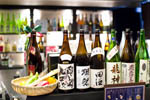Fish Trap
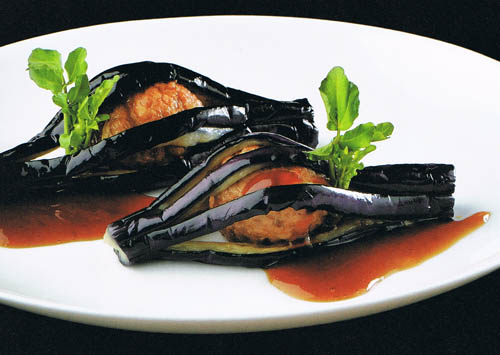
Stuffed Eggplant
If you love stuffed eggplant, here's a new way to present it. The eggplant entwines the food, giving the diner a peek at what is to come. Inspired by the traditional river traps of old that were fashioned from tubes of giant bamboo, the Fish Trap garnish becomes a major element of the dish itself.
Use small eggplants and you have an attractive appetizer, larger ones and you're all set for your main course. Consider stuffing with shrimp balls, a vegetable-and-tofu mixture, diced cubes of meatloaf, or just about anything that comes to mind. Bake or deep-fry, depending on your preferences and choice of stuffing.
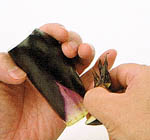
1. Trim both ends of an eggplant. |
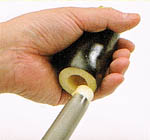
2. Hollow out the center with a punch or an apple corer. |
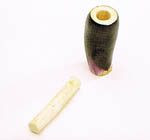
3. After the core is removed... |
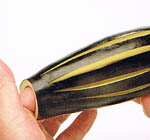
4. ... make vents in the side of the eggplant and cook. |
After the Fish Trap is made, the eggplant is deep-fried then the chicken balls are set ever so gently inside, and the Trap is closed up again. Drain the eggplant well before stuffing. Depending on your choice of stuffing, you may want to bake the eggplant and stuffing together, or prepare the stuffing ahead of time and then bake.
Chrysanthemum
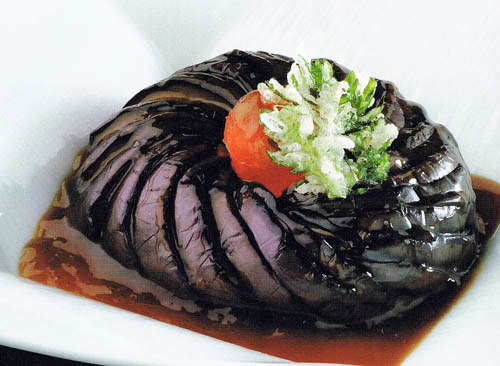
Eggplant Chrysanthemum in a Japanese Wine Sauce
Making this decorative eggplant "garnish" is simplicity itself, yet when served it exhibits the epitome of elegance. Simply make incisions, deep-fry, and press down gently. The trick is to space your cuts evenly so that when the eggplant is pushed down to form the flower, the "petals" spread out cleanly for a spectacular finish.
The eggplant is topped with a boiled egg yolk seasoned with miso and a sprig of tempuraed greens, but add any food that brings out the eggplant's rich purple hue.

1. Cut the top from an eggplant to form a flat base. Make evenly spaced incisions from top to bottom, stopping short at each end. |
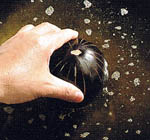
2. Deep-fry in hot oil, putting the top end (cut end) in first and holding the eggplant in place for a few seconds. |
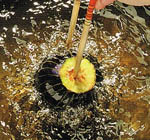
3. Cook the other side, top up, until soft in the center. Remove from the oil, drain, then set the eggplant on a clean surface and press down gently to form a round shape. |
A round eggplant yielded the shape here, but the bulbous end of an oblong specimen will also produce good results. Trim one end flat, make incisions, and deep-fry at about 370°F (190°C). When deep-frying, cook until the center is soft. Test with a skewer. Drain well.
Source Notes
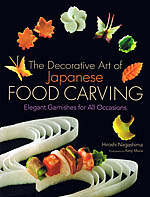
Reprinted with permission from the book:
The Decorative Art of Japanese Food Carving: Elegant Garnishes for All Occasions
Kodansha International
Japanese cuisine is renowned for the beauty of its presentation. Among the key elements in this presentation style are mukimono -- the decorative garnishes and carvings that add the final flourish to a dish.
In The Decorative Art of Japanese Food Carving, internationally acclaimed chef Hiroshi Nagashima offers 60 edible garnishes and food carvings for home, party or professional use. Some are designed to be set on top of the food. Others are fashioned to hold the food -- and sometimes, they simply are the food.
Each is introduced in full color, with easy-to-follow, step-by-step instructions, sample food arrangements, further ideas and secret, insider tips for successful presentation. Most are simple enough for the amateur chef to master, although a few are quite challenging and require much practice.
The Decorative Art of Japanese Food Carving is more than a practical handbook, however. It is also an inspiration book, filled with creative suggestions and inventive ideas to enhance and transform the way we cook.
ISBN4-7700-3087-8
- Order this book from amazon.com
- Order this book from amazon.co.jp (in Japan)
- Find this book at your local English-language bookstore in Japan
- Or use the ISBN to order from your local bookstore.
More articles
- © Copyright Lobster Enterprises
- Privacy
- Bento.com top
- © Copyright Lobster Enterprises
- Privacy
- Bento.com top
- © Copyright Lobster Enterprises
- Privacy
- Bento.com top








